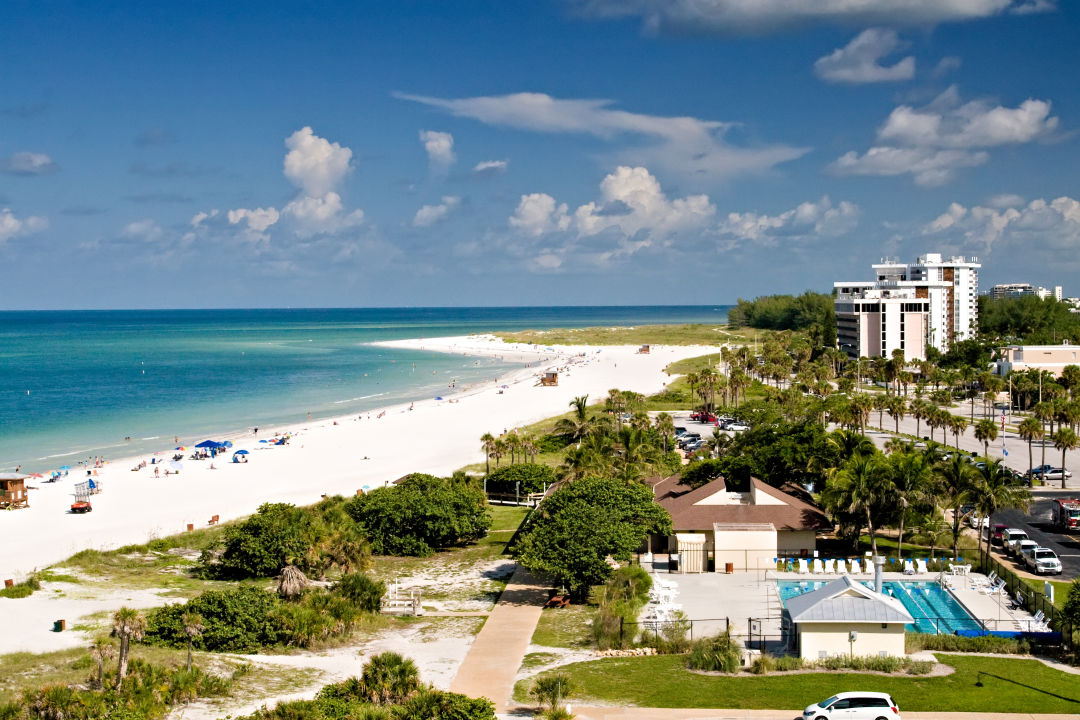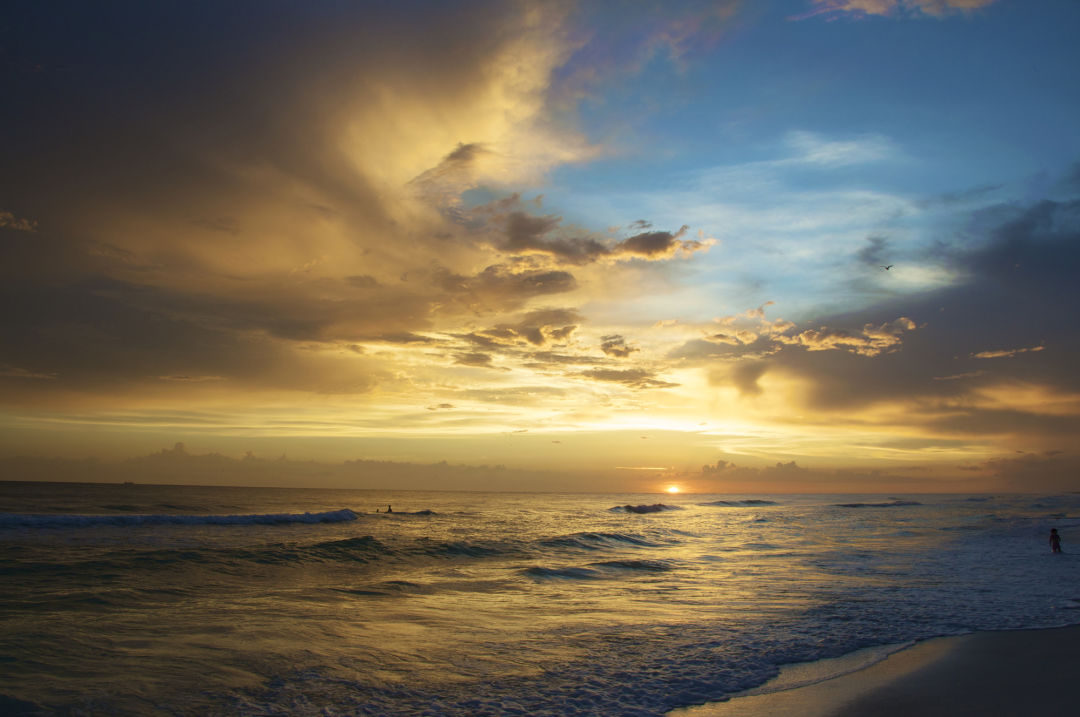What to Do on St. Armands/Longboat Key

A view of Lido Beach
The Beaches
Longboat Key
Longboat Key’s beaches are rich in history. A centuries-old ship’s boat has been unearthed from these sands, and they also were the foundation for our first world-class resort, the Ritz-Carlton that John Ringling envisioned in the 1920s before a real estate collapse stopped construction. Once known as Palm Island, then Long Key, and for the last 100 years as Longboat Key, the island was covered by a forest of West Indies juniper and sabal palms, a rich green backdrop to the brilliant white sand beaches that greeted the area’s earliest explorers, surveyors and settlers.
By 1910, Longboat Key was the site of farms growing tomatoes and other cold-sensitive crops. The main settlement was the village of Longbeach at the north end of the key, with a popular bathing beach, but the rest of Longboat Key was largely undeveloped until John Ringling began construction of a beachfront golf course and his grand hotel.
While Ringling’s dream hotel was never completed, beachfront residences, most of them condominiums, have risen like sandcastles, creating a destination of secluded relaxation. No longer wild and natural, the beach is renourished to maintain a uniformly sculpted ribbon of sand. Beyond the beach, Longboat’s plush landscaping and fine restaurants create a sophisticated tropical atmosphere. A few public accesses with limited parking allow visitors to enjoy the quiet and often nearly deserted beaches. No lifeguards or amenities.

Image: Jack Elka
Lido Key
Lido Beach (400 Ben Franklin Drive) offers a tremendous diversity of experiences, from the remote stretch of sand known as North Lido to the popular Lido Public Beach and the über-natural beach at the island’s southern point. With the adjacent St. Armands Key shopping district, easy access to downtown Sarasota and several beachfront hotels, Lido has always been a tourist’s delight.
Once known as the Cerol Isles, the name was changed to Lido by John Ringling in the 1920s. The Italian name reflects the circus king’s fascination with all things European, and his efforts to put Sarasota on the world map. From 1940 through the 1960s, Sarasota’s premier beachfront destination was the Art-Deco-style Lido Beach Casino, with its enormous concrete sea horses facing the waters of the Gulf. In the 1960s Lido hosted the contestants of the Miss Florida Pageant in their one-piece Jantzen swimsuits. Lido Beach, tremendously popular with locals as well as visitors, has lots of parking, concession stand, restrooms, lifeguards and a swimming pool.
The secluded southern point of the island is the home of Ted Sperling Park, also known as South Lido Beach (190 Taft Drive), one of Sarasota’s most popular eco-tourism destinations. Nearly surrounded by the Gulf, Big Pass, Sarasota Bay and the Brushy Bayou estuary, this nature park is famous for kayak tours through enchanting mangrove tunnels. There are strong currents in the water at the pass and no lifeguards, so use caution. —John McCarthy
The Homes
You’ll find a variety of architectural styles in residential buildings around Sarasota and her keys, but what puts us squarely in the international spotlight are the historic homes built chiefly from 1940 to 1970 in the style that came to be known as the Sarasota School of Architecture.
Modern influences including the European international style and the works of Frank Lloyd Wright were interpreted by up-and-coming architects (including Paul Rudolph, Gene Leedy, Victor Lundy and others) to fit the semitropical environment, typically employing wide roof overhangs for shade, expanses of glass to blend the indoors and outdoors, and site placement that made the most of sea breezes. Several of the most famous homes built in this period and style are clustered on Lido Shores, such as the famous Umbrella House, the Hiss Studio and the Harkavy House, most dating from the 1950s. But the tradition is carried on in more contemporary homes and renovations here, too.
It’s easy—and fun—to take a self-guided tour of our iconic architecture. A free booklet (with map) detailing not only the Lido Shores area, but other significant buildings, is available for pickup at the visitor center at 1710 Main St. in downtown Sarasota.

The shark tank at Mote's Aquarium
Image: Photo Courtesy Mote Marine
The Sealife
Pet a stingray, watch a shark feeding and be awed by jellyfish at Mote Marine Laboratory & Aquarium—just a short drive, bike ride or stroll from St. Armands Circle.
Scientists are onsite doing marine biological research in the lab while visitors view 100-plus species of sea creatures in the aquarium. Check out the two touch tanks, resident manatees Hugh and Buffett, the 135,000-gallon shark habitat, the rotating exhibits (Sea Debris: Awareness Through Art , on exhibit through June 15, features large-scale sculptures made entirely of trash washed up on Oregon shores) and the ’50s-style retro Deep Sea Diner.
Next door to Mote is Save Our Seabirds, a sanctuary for rescued Florida birds and worth a visit. And, from February to May, you can watch a free Sarasota Ski-A-Rees water show on a Sunday afternoon at the adjacent stadium.
Mote admission is $22 for adults, $16 for children ages 3 to 12, and free for children ages 2 and younger (free for Mote members). 1600 Ken Thompson Parkway, Sarasota, (941) 388-4441, mote.org—Abby Weingarten
The Circus
Sarasota is a city with an enduring Big Top culture, and the Circus Ring of Fame on St. Armands Circle embodies that spirit.
The historic Ring at Circle Park, inaugurated in 1987, gives visitors a chance to applaud the town’s famous circus performers. Each winter, the public nominates honorees to receive bronze wheel plaques, and organizer Brian Liddicoat coordinates the induction ceremony in mid-January.
“The importance of balancing the Sarasota community with its circus history is nowhere more publicly expressed than on the Circus Ring of Fame,” says Liddicoat, a circus historian for more than a half-century. “The inductees devoted their lives to their craft: jugglers, clowns, aerialists, animal trainers and more.”
The Ring also pays tribute to John Ringling, who purchased St. Armands Key in 1917 and helped draft the plans for St. Armands Circle. In the 1920s, Ringling made Sarasota the winter headquarters of the Ringling Bros. and Barnum & Bailey Circus, and that’s how the city became a second home for circus folk.
Today’s Ring of Fame is replete with plaques that recognize such celebrities as the Flying Wallenda aerialists, animal trainer Gunther Gebel-Williams, clowns Lou Jacobs and Emmett Kelley, and showmen John Ringling and P.T. Barnum. So as you stroll around the park, see how many circus show people names you recognize.—Abby Weingarten
The Food
Bet you didn’t know that the five Columbia restaurants in Florida, including the bustling St. Armands Circle branch, together are the largest users of Worcestershire sauce in the U.S.
That’s just one of the delicious nuggets of history, pop culture, circus lore and just plain fun facts we learned when we signed up for Key Culinary Tour’s flagship St. Armands Lunch Tour. It’s the brainchild of Sarasota’s Susan Robinson, owner of the property management company, Key Concierge, who saw a void and filled it. The lunchtime culinary tours she started nearly two years ago have blossomed into other specialty tours, including a St. Armands happy hour tour and a farmer's market tour.
The Columbia was one of six stops on our lunch excursion. As our waiter splashed the Columbia’s famed 1905 salad with a dash of Worcestershire, manager John Monetti told us that, on any given day in-season, the restaurant serves an average 750-plus of the garlicky dish, named for the date the original restaurant in Tampa’s Ybor City was founded. (Now you know why the company uses so much Worcestershire sauce.) We each got a generous portion, along with half a Cuban sandwich.
At Shore Diner, we enjoyed the bright flavors of the signature lobster, crab and shrimp Cobb salad along with the calamari and Asian slaw salad and a big helping of Shore’s popular truffle fries with Parmesan and chives. Restaurant owner Mark Caragiulo welcomed us to the trendy eatery, which he describes as “midcentury Florida in spirit, with an elevated take on American comfort food.”
At Blu Kouzina, we sampled the flavors of Greece: deep fried meatballs with tzatziki; zucchini patties with herbs, feta cheese “and a lot of love,” according to our waiter, a chicken kabob with roasted potato, and a piece of not-too-sweet baklava. And at Tommy Bahama, dessert awaited us in the form of three beautifully composed miniature desserts: a Key lime cake, triple chocolate malted cake and peanut butter pie.
Robinson also took us to the Spice and Tea Exchange, where we absorbed the fabulously fragrant scents of the spices, and to the Savory Palate, where we tried a refreshing glass of seltzer water flavored with white peach balsamic vinegar.
Robinson says half the people who’ve taken her tours in this inaugural year have been out-of-towners and the other half locals, half of whom have never been to one or more of the restaurants on her tour. “It’s a marvelous way to see a neighborhood,” she says.—Ilene Denton


